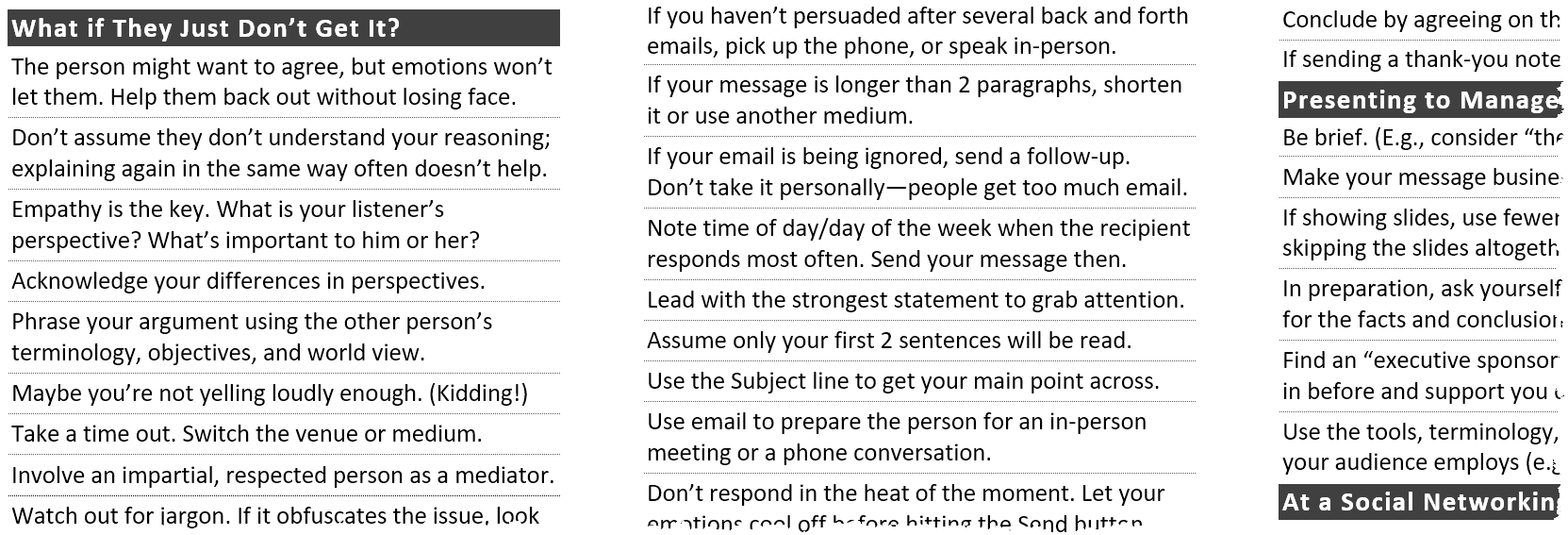
This cheat sheet offers communication and collaboration tips for technologists, engineers, and information workers. To print, use the one-page PDF version; you can also edit the Word version for you own needs.
What if They Just Don't Get It?
- The person might want to agree, but emotions won't let them. Help them back out without losing face.
- Don't assume they don't understand your reasoning; explaining again in the same way often doesn't help.
- Empathy is the key. What is your listener's perspective? What's important to him or her?
- Acknowledge your differences in perspectives.
- Phrase your argument using your the other person's terminology, objectives, and world view.
- Maybe you're not yelling loudly enough. (Kidding!)
- Take a time out. Switch the venue or medium.
- Involve an impartial, respected person as a mediator.
- Watch out for jargon. If it obfuscates the issue, look for a way to get it rephrased.
- Track interaction approaches that work with the person; stick to the method that succeeded earlier.
- Maybe you're wrong. It happens to the best of us.
Persuading a More Technical Person
- Research technical aspects of the issue beforehand. What objections or new data may arise?
- Get solid data to support your argument. Be ready to drill into details.
- Remember that people often decide based on emotions, even when presented with data.
- Practice in front of a friendly more technical person.
Persuading a Less Technical Person
- Don't make the other party feel dumb due to the lack of technical insight. Sounding superior backfires.
- State your conclusion first, before discussing the details of how you arrived at it.
- Research non-technical aspects of the issue beforehand. What objections or new data may arise?
- Practice in front of a friendly less technical person.
Tips for Better Email Messages
- If you haven't persuaded after several back and forth emails, pick up the phone, or speak in-person.
- If your message is longer than 2 paragraphs, shorten it or use another medium.
- If your email is being ignored, send a follow-up. Don't take it personally—people get too much email.
- Note time of day/day of the week when the recipient responds most often. Send your message then.
- Lead with the strongest statement to grab attention.
- Assume only your first 2 sentences will be read.
- Use the Subject line to get your main point across.
- Use email to prepare the person for an in-person meeting or a phone conversation.
- Don't respond in the heat of the moment. Let your emotions cool off before hitting the Send button.
- Don't forget about non-email mediums: phone, postal mail, LinkedIn, Twitter, Facebook, billboard, tattoo, etc.
In-Person Conversations
- Dress appropriately for the venue, topic, expectations, and social norms.
- Consider where to speak: your workplace, his or her workplace, water cooler, lunchroom, etc.
- Find the best timing: some are grumpy in the mornings, sleepy after lunch, in a hurry at 5pm, etc.
- Come prepared. Impromptu talks on important topics have been known to lead to trouble.
- Harness the power of sharing a tasty treat.
- When in doubt, use a breath freshener.
- If you or the other party are in a foul mood, consider putting the conversation on hold and resuming later.
- Mimic the other party's general posture and gestures, but not exactly movement for movement.
- Be mindful of cultural differences in gestures and the distance between speaking parties.
- Smile. Breathe. Don't avoid eye contact.
- Practice a strong handshake. No limp wrist!
- Conclude by agreeing on the next steps and timeline.
- If sending a thank-you note, send it ASAP.
Presenting to Managers and Executives
- Be brief. (E.g., consider "the elevator pitch.")
- Make your message business-relevant.
- If showing slides, use fewer bullet points. Consider skipping the slides altogether.
- In preparation, ask yourself and answer, "So what?" for the facts and conclusions you will discuss.
- Find an "executive sponsor" who will offer feedback in before and support you during the presentation.
- Use the tools, terminology, and conventions that your audience employs (e.g., the SWOT matrix).
At a Social Networking Reception
- Come early—fewer people and attendees are fresh.
- Don't stay by your friends' side. Meet new people.
- It's OK to come up to groups of strangers and join a conversation. Receptions are public conversations.
- Welcome newcomers into your conversations.
- Prepare chit-chat topics by reading news, books, etc.
- Hold an appropriate prop (e.g., wine glass) in one hand, but have one hand free to shake hands.
- Use people's names when speaking with them.
- Be enthusiastic. Try to look friendly, approachable.
Improving Communication Skills
- Improvisational or stand-up comedy classes help.
- Consider joining a local Toastmasters club.
- Attend writing workshops (creative, resume, etc.).
- Practice on friends and in low-risk environments.
- Article: How to Be Heard in IT Security and Business
Post-Scriptum
This cheat sheet is distributed according to the Creative Commons v3 "Attribution" License. File version 1.5.
Updated September 15, 2017